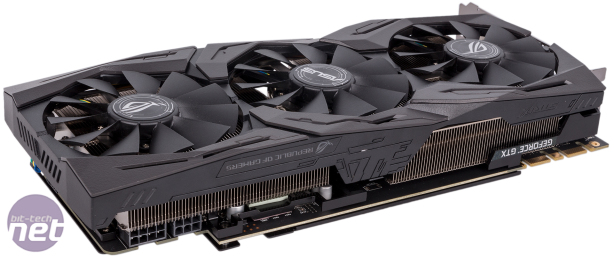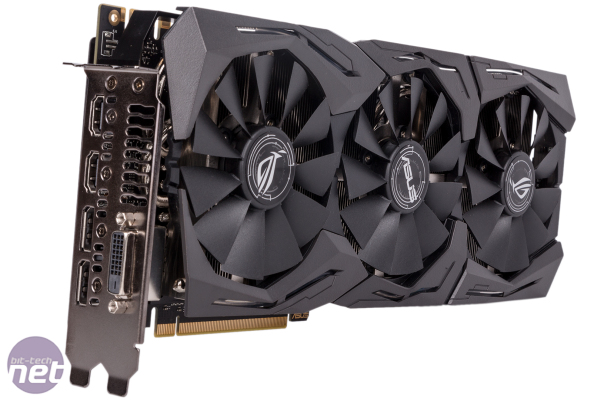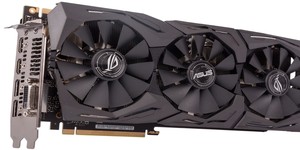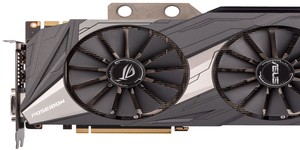Performance Analysis
Across our suite of five games (the Doom benchmark isn't working currently; we're working on a fix), the Asus card with the new, faster memory is just under four percent quicker than the EVGA GTX 1080 FTW, which uses 10Gbps VRAM. The difference is even smaller when we compare it to the Aorus GTX 1080 11Gbps – in most tests the average frame rate is the same. In short, the 11Gbps memory is nice to have, but it's not going to make a big difference in games. The GTX 1080 remains a potent, uncompromising force at 1440p, but at 4K there will be a few games that push it just a little too hard for it to remain smooth – it's the same story we've seen with every other GTX 1080, basically.AMD is absent from this end of the market still, but the GTX 1080 11Gbps is relatively well positioned in Nvidia's stack. We see a 20 percent lead here over a heavily overclocked GTX 1070, which is of course the better value card, while third-party, overclocked GTX 1080 Ti cards are on the flip-side close to 30 percent quicker than what we see here.
In its default Gaming Mode, this card's boost speed is not consistent, although it tends to hover around the 1,900MHz mark and is power-limited rather than thermally. This is evidenced by OC Mode, which increases the power limit by 10 percent and sees the boost speed of 1,949MHz maintained pretty much without falter. Silent Mode, meanwhile, introduces more fluctuation thanks to the lower power limit: We typically observed a boost speed of just over 1,800MHz here.
Perhaps the most surprising aspect of this card's performance is its power consumption. Astonishingly, it saw our system consuming less than when we used a heavily overclocked GTX 1070, and was lower too than AMD RX 570 cards which are nowhere near it in terms of performance. The efficiency is truly excellent, and it suggests that Asus isn't telling fibs about the capabilities of its Super Alloy Power II components, as other GTX 1080 cards have been closer to 350W system power consumption. The different power limit settings included with the built-in profiles do make a difference too – power consumption hit 318W in OC Mode, but was constrained to just 272W in Silent Mode.
The massive cooler barely broke a sweat in testing either. The fan speed hit 35 percent (just under 1,300 RPM) in Gaming Mode, rising to 37 percent in OC Mode and dropping to 33 percent in Silent Mode. These differences are small in terms of noise, and the card is always quiet. The temperature is also very low, with the delta T of 37°C being just 2°C warmer than the R9 Fury X, which in case you've forgotten is a water-cooled card! Interestingly, the lowest manual speed setting for the fans available seems to be 38 percent, so you don't actually have the option to keep the card running even quieter (and a bit hotter) by manually limiting fan speed, which is our only gripe, as there's clearly enough headroom to do so.
Overclocked, we saw system power consumption reach 332W, while boost speeds hovered between 1,975MHz and 2,025MHz. The temperature climbed to a delta T of 41°C (still very low), while the fans finally hit the 40 percent mark (still quiet). In return, we saw performance improve by five or six percent.
Conclusion
When we reviewed the GTX 1080 Ti Strix OC, we finished our review by saying that we had seen no finer card pass through our labs. A look at this card confirms those findings – this latest Strix design is truly one to be reckoned with.There are some downsides, such as the sheer size of the thing and also the cost. Addressing the first point, more and more cases and motherboards are being released that support cards of this size, so putting together a compatible system won't be difficult. As to the cost, this is a card that's about having your cake and eating it, and it's hard to argue that Asus doesn't deliver in this regard. The clock speeds could arguably be higher on both the core and memory, but there's not much more to be squeezed from it - we're talking single-digit percentages that you probably would never notice in real life.
Be it aesthetics, build quality, efficiency, or thermals, whatever way you look at this card you're bound to be met with high quality. At £600, the card is tantalisingly close to the lower end of GTX 1080 Ti pricing and is not well positioned on the price-performance spectrum as a result. However, we'd wager that most people shopping at this level of GPU aren't looking to maximise bang for buck solely in terms of performance, and this card is seriously impressive in every other aspect – the power consumption and temperature figures are truly epic. For 1440p gamers, this is the card to get if you can afford it.


MSI MPG Velox 100R Chassis Review
October 14 2021 | 15:04












Want to comment? Please log in.